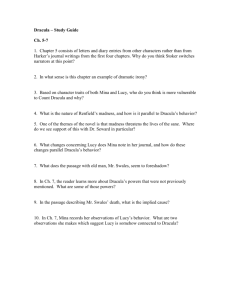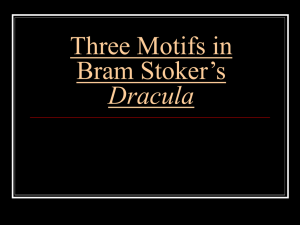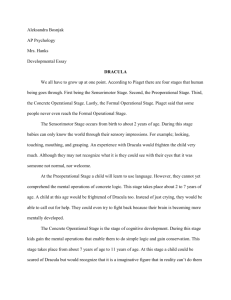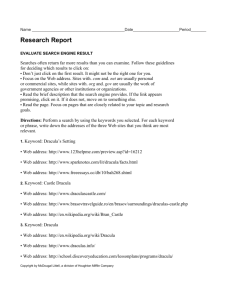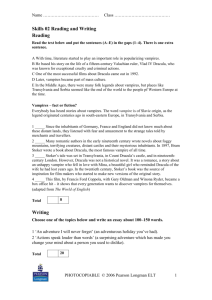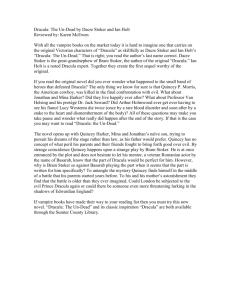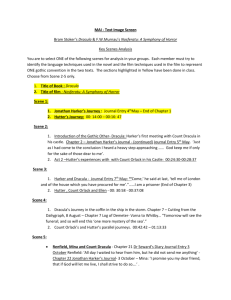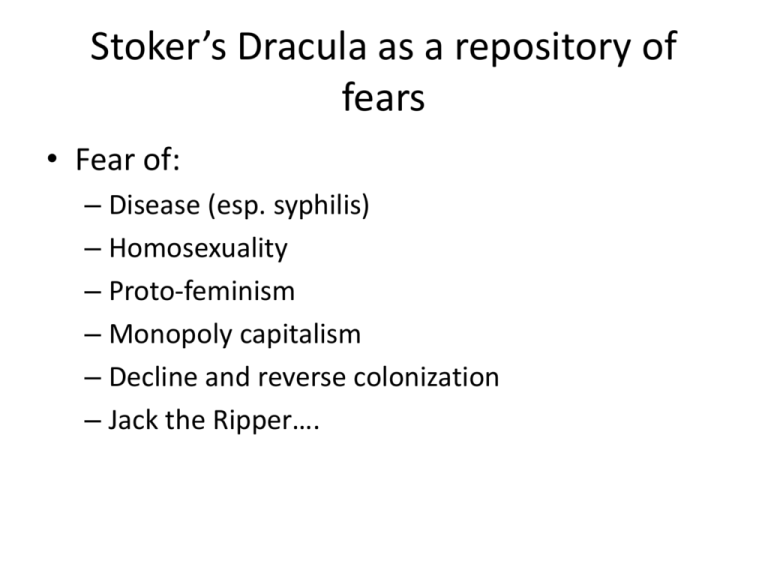
Stoker’s Dracula as a repository of
fears
• Fear of:
– Disease (esp. syphilis)
– Homosexuality
– Proto-feminism
– Monopoly capitalism
– Decline and reverse colonization
– Jack the Ripper….
Bram Stoker (1847-1912)
• Irish by birth, lived in
London
• Other works included
“The Lair of the White
Worm” (1911)
• Married to Florence
Stoker
Stoker
• Worked for Henry Irving
as personal assistant
and business manager
to Lyceum Theatre
Erzsébet Bàthory (1560-1614)
Vlad the Impaler (1431-1476)
Vlad Tepes and victims
Vlad Tepes
Image of Vlad Tepes from 1700s
Russian Boyar
Castle Bran
Secret Passage in Castle Bran
Ruins of Dracula’s fortress
Snagov Monastery
Snagov Monastery
Snagov Monastery
Legends of Vlad Tepes
Elizabeth Kostova, The Historian (2005)
Inspiration
• My Friend Arminius of Buda-Pesth University
(212)
• “Legend of Voivode Dracula” (212)
Notes to Dracula
Broadside about Vlad
Bram Stoker (1847-1912)
Varney the Vampire (1845-47)
• James Malcolm Rymer
• Thomas Preskett Prest
• Serialized novel,
published as book in
1847
• The character of Varney
Dracula, 1897
Murnau’s Nosferatu (1922)
Bela Lugosi
Herzog’s Nosferatu (1979)
Christopher Lee and Hammer Studios
Christopher Lee as Saruman the White
Victorian Era (1837-1901)
• Period of growth and
prosperity
• Height of Empire
• Rapid population
growth in England
• Significant technological
and medical
developments
London (Grimshaw, Hamstead Hill,
1881)
• “Lucy lies in the tomb of
her kin, a lordly
deathhouse in a lonely
churchyard, away from
teeming London; where
the air is fresh, and the
sun rises over
Hampstead Hill, and
where wild flowers
grow of their own
accord” (295)
Victorian Era (1837-1901)
• Era of sexual repression
or “sexual anarchy”
• “a time when all the
laws that governed
sexual identity and
behavior seemed to be
breaking down”
• Elaine Showalter,
Sexual Anarchy, 1990)
London
• 53
• “teeming millions”
Highgate Cemetery
Highgate Cemetery
Highgate
Tombs at Highgate
Piccadilly Circus c. 1894 (p. 367)
Jack Straw’s Castle (311)
Spaniard’s Inn
Spaniard’s Inn Interior
Whitby Abbey
Whitby Abbey
Whitby Abbey (64)
Steps to Whitby Abbey
Lucy and Mina as types of womanhood
• Lucy, pampered, restless; in her undead form
she becomes a sexualized murderess,
attacking children
• Mina, a more independent, modern woman,
but she is not a “New Woman,” she still has
very conservative values
Women in Dracula
• Can we read the first half as an assault on the
“New Woman” and the second half as the
elevation of an idealized woman?
The New Woman
• 86—what would shock
the “New Woman”?
• 87-- New woman would
propose herself
• The New Woman was
open to all kinds of
freedoms, including
sexual freedom
•
The New Woman
• 60 Why can’t a woman
marry three men?
• 158 This sweet maid is
a polyandrist
Burne-Jones: “The Vampire”
• Painting accompanied
Kipling’s poem “The
Vampire” (1897)
Mrs. Patrick Campbell
Theda Bara 1910
The wicked temptress
• “I felt in my heart a
wicked, burning desire
that they would kiss me
with those red lips” (42)
•
Frank von Stuck (1863-1928), “Sensuality”
The Dead Beauty
• “She makes a very
beautiful corpse, sir”
(147)
•
“Ophelia,” John Millais, 1850
Toby Rosenthal, “Elaine,” 1874
The Invalid
• Why do we view Lucy’s
corpse and the content
of her coffin so often?
•
•
Carl Larsson, “The Invalid” (1899)
Frank Dicksee “The Crisis” (c. 1891)
“The Household Nun” (Dijikstra)
• Abbott Handerson
Thayer, “Virgin
Enthroned,” 1891
Thomas C. Gotch, “Holy Motherhood,”
1902
Da Vinci, “Madonna and Child”, 147580
Domenico Ghirlandaio, “Madonna
Enthroned with Saints”, 1484
Lucy’s transformations
• 146—her voluptuous
voice
• 176 Her coffin is empty
• 179 Lucy Un-Dead in
her coffin
Lucy as sexualized monster
• 188 Calling out to
Arthur: Come to me
• 192 A nightmare of Lucy
• 192 holy calm that lay
like sunshine
Sexual symbolism and Lucy’s demise
• “No man knows, till he experiences it, what it
is to feel his own life-blood drawn away into
the veins of the woman he loves” (119)
• 192—He looked like a figure of Thor
• (Contrast with “The Mysterious Stranger”)
Monstrous motherhood
• The Count’s women attack children (48)
• Lucy terrorizes the children of Hampstead
(159)—the “bloofer lady”
• A white figure holding a tiny child (177)
• Lucy flings the child to the ground (188)
Mina
• Works as “assistant schoolmistress” practices
shorthand (55)
• Wants to protect Jonathan (163)
• Not of a fainting disposition (198)
• Man’s brain and a woman’s heart (207)
Mina
• Is Stoker trying to give
us a woman who is the
best of the “new” and
“old” Woman?
The attack on Mina and notions of
purity
• Represented as a type of rape (247)
• Unclean (248)
• Dracula will use her as “wine-press” and then
“companion” (252)
• Called by the three woman (317) who have
attacked Jonathan (42ff)
Dispensing with Lucy’s corpse
• Why mutilate her body without need? (149)
• Opening her grave is like stripping off her
clothes (176)
• May I cut off her head? (183)
Lucy’s body
• Until 1823 Anatomy Act, convicted murderers
were doomed to dissection.
• Lower class readers may have viewed the
scene where Lucy’s corpse is dealt with
differently than others (Williamson, Lure of
the Vampire, 2005)
Lucy’s corpse
• “Lucy’s vampiric corpse, it seems, is a
repository of all that the patriarchal medical
and legal establishment loathed and desired”
(Williamson, 21)
• Lucy is “more virtuous after death”
“vampirism in Dracula does not challenge
marriage…it inculcates the restraints of
marriage in a reluctant girl” (Auerbach, 160)
Sexuality and Disease
• Syphilis
• Fifteen hundred infants died annually from
STDs between 1880 and 1900
• Syphilis often passed to wives and children
• Parallels to syphilis: tainted women, diseased
blood, quack cures
The threat of the homoerotic
• “This man belongs to me!” (43)
Stoker and Wilde
• Stoker begins writing Dracula a month after
Wilde is convicted (May 24, 1895)
• Dracula as a “ghoulish inflation” of the current
view of the homosexual as seducer of young
boys
Stoker, Wilde, Dracula
• Dracula (193-3)
• Description of Wilde by an acquaintance of
Stoker: “There was something oily and fat
about him that repelled me. His hands were
flabby, greasy; his skin looked bilious and
dirty…his appearance filled me with distaste. I
lay stress on the physical repulsion, because I
think most people felt it.”
Dracula and homosexuality
• Dracula as a metaphor for the life of a
homosexual in Victorian England : the need
for secrecy, shrouded curtains, no servants,
nocturnal visits (Shaffer)
• Stoker’s depiction part of a general fear of
“decline” and “degeneration”
Dracula and Homosexuality
• McCrea—looks at Stoker as “closeted” writer
• “Dracula, I want to suggest, is a novel about
heterosexuality as it is viewed from … the gay
closet—as an exotic foreign world, at once
alluring and frightening” (253)
Dracula and “Occidentalism” (Arata)
• Novel as an engagement with “the Eastern
question”
• Carpathians known for cultural upheaval and
radical shifts in imperial control
Dracula and “Occidentalism”
• Van Helsing: vampires always follow conquest
(463)
• Dracula traces his own powerful bloodline (35)
• His vampirism is woven into his conqueror
status
Dracula and Occidentalism
• Dracula trains himself to conquer England, as
a Western Orientalist would train
• His victim is Lucy Westenra –light of the West
• The white Lucy is a “civilizational cause”
(Wicke, 481); her suitors have served in exotic
places
Dracula and “Occidentalism”
• Vampires come in the wake of imperial decay
Dracula chooses England because it is in decline
Jonathan fears unleashing Dracula on London—
a type of reverse colonization
Dracula and “Occidentalism”
• “If in this novel blood stands for race” Lucy
and Mina, women in general, become
“vehicles for racial propagation” (Arata 468)
• Count’s practice is a perverse mirror of
Orientalism
Whitechapel Murders, 1888 (Jack the
Ripper)
Antisemitism and Dracula
• “smelled old Jerusalem” (201)
“Science” of Physiognomy (see page 296)
Science
•
•
•
•
Vivisection
Sleeping draughts
Transfusion 113
Charcot 171
Physiognomy
• Jonathan notes Dracula’s “very marked
physiognomy” (23)
• Appearance of the Count’s women (42)
Physiognomy
• 163
• 168
• Dracula has a “child brain” a “criminal brain”
Van Helsing
• First mention 105
• Man of Science with an “Indulgence” (187)
Class
• 134—serving women and the drink
• 135—customs of the lower classes
• 150—stolen crucifix
Modernity and Dracula
• “It is nineteenth century up-to-date with a
vengeance. And yet, unless my senses deceive
me, the old centuries had, and have, powers
of their own which mere “modernity” cannot
kill” (Harker’s diary;)
Modernity and Dracula
• “Good God, Professor!” I said, starting up. “Do
you mean to tell me that Lucy was bitten by
such a bat; and that such a thing is here in
London in the nineteenth century?” (Dr.
Seward’s Diary; 172)
• “our scientific, skeptical, matter-of-fact
nineteenth century” (210)
Horror in/of (?)the age of
mechanical reproduction
•
•
•
•
•
Phonograph
Typewriter and reproduced narrative
Stenography
Photography
Journalism
Photography
• Jonathan brings Kodak photographs to Dracula
• “Kodak” meant eye-witness proof at the turn
of the 19th century
• Linked perhaps to the idea of the tourist—
Jonathan is involved in a type of tourism gone
desperately wrong
Phonograph
• Invented by Edison in
1878 and “perfected” in
1888
• 197—”a wonderful
machine ,but cruelly
true”
• 198—Mina hears the
story of Lucy’s death
Technology and narrative
• Mina and Seward exchange stories through
the phonograph and typewriter
Typewriter
• First mass produced in
1870s by the Remington
Company
• Typewritten text was
seen as the “preeminent symbol of
modern truth”
(Richards 449)
• But how it that truth
viewed in Dracula?
Stenography
• Part of the new and
growing professionalism
• A code Dracula does not
know
• A way of capturing
speech
Journalism
• Technological innovations make “near-realtime news relay and mass production
possible” (Richards)
• Huge growth in journalism during 19th c.
• Journalism becoming increasingly
professionalized
• Stoker includes newspaper accounts
Journalism
• Mina gathers newspaper accounts
• Use of newspaper accounts, assembled by
Mina, gives authority to the other voices in
the text (Richards, 454)
Technology and narrative
• How is this story told?
• Epistolary? Journalistic?
• Jonathan assembles accounts seven years
after the fact
Technology and narrative
• “We were struck by the fact, that in all the
mass of material of which the record is
composed, there is hardly one authentic
document; nothing but a mass of typewriting,
except the later notebooks of Mina, Seward
and myself, and Van Helsing’s memorandum.
We could hardly ask any one, even did we
wish to, to accept these as proofs of so wild a
story” (326)
Narrative and Technology
• What is the status of modern technology in
this novel? Is it an engine for truth and a tool
for good? Is its status questionable and
inauthentic?
• Kittler: “Stoker’s Dracula is not vampire novel,
but rather the written account of our
bureaucratization. Anyone is free to call this a
horror novel as well” (74).
• Walter Benjamin: “In even the most
perfect reproduction, one thing is lacking:
the here and now…its unique existence in
a particular place…the here and now of
the original underlies the concept of its
authenticity…[the] whole sphere of
authenticity eludes technological—and of
course not only technological
reproduction”
•
The Work of Art in the Age of Mechanical Reproduction--Das Kunstwerk im
Zeitalter seiner technischen Reproduzierbarkeit (1936)
Technology
• What are the limits of technology?
• The group uses technology to defeat Dracula,
but they have limits
• Mina makes copies, but it is her analysis that
triumphs: “her eyes have seen where ours
were blinded”
The Professions
• How are the characters
experts/professionals—what is the
significance of this role?
• Mina: “I have been working very hard lately, because I
want to keep up with Jonathan’s studies, and I have
been practicing shorthand very assiduously. When we
are married I shall be able to be useful to Jonathan,
and if I can stenograph well enough I can take down
what he wants to say in this way and write it out for
him on the typewriter, at which also I am practicing
very hard…I may show it to Jonathan some day if there
is in it anything worth sharing, but it is really an
exercise book” (55)
• Mina and Jonathan are engaged with keeping
accurate records (198—dates are everything)
• Mina “believes that accuracy will give them
power over Dracula” (Richards, 448)
Forms of Reproduction
• Vampires creating new vampires
• Mina and Jonathan’s son (whose blood runs in
his veins)
• Technology as a way of reproducing (Mina’s
typewriter, for example, has a “Manifold”
function)
“the nature of the vampire”
• 210-211
Sources
• McCrea, Barry. "Heterosexual Horror: Dracula,
the Closet, and the Marriage-Plot." Novel: A
Forum on Fiction 43.2 (2010): 251-70. Print.
• Dracula page numbers from Norton

